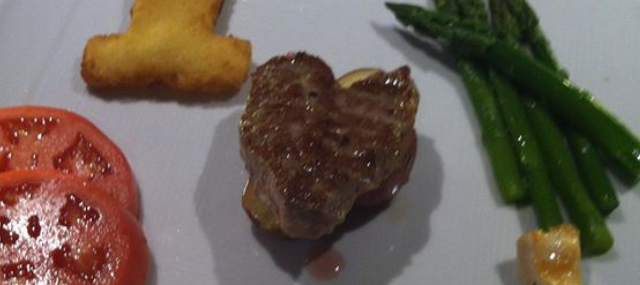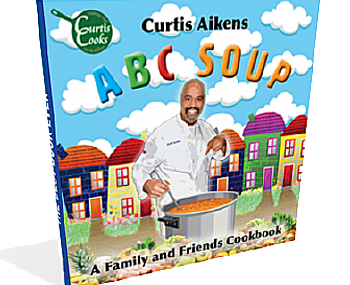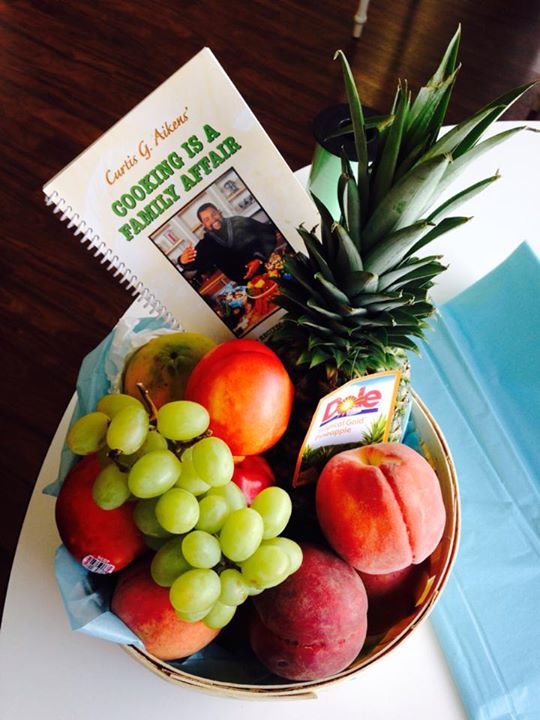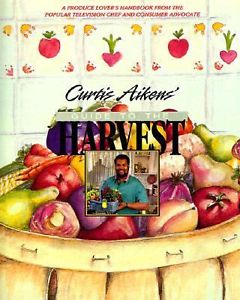blog
Julia Child & Me, Curtis G
Curtis Me & Julia Child I sometimes say during my live presentations that I have lived a Forrest Gump-ish life. I think of that statement and laugh out loud, because it is so true, this guy Me, from Conyers Georgia has traveled the globe and met world-famous history-making human beings. Wow… don’t be afraid to ask for what you want, because you can get it. I even have a funny meet and greet with a President in the White House. That as they say is another story, for some other day. I sometimes look back in amazement at all the people, famous people, infamous people, incredible people that have crossed my path. Or should I say I crossed their paths! Truth is, our paths met at some point. That is one of the reasons I most times say to my live audiences “I am the most blessed person on Earth” Julia Read More…
Heart&Soul
This book is dedicated to my earthly lights: my boys Curtis George Aikens, Jr., and Cole Bennett Aikens. I love you boys with everything I’ve got. My hope and prayer is that someday our family will be whole. This dedication extends to parents and children everywhere who find themselves struggling to stay a family despite divorce or separation. May the God I love walk with you and keep you safe. From: CURTIS COOKS WITH HEART AND SOUL I remember writing that dedication, quite a while ago, the boys are grown now, and I have very little interaction with the men they have become. Which is ok, they want and need to grow their lives same as I did years ago when I up and left Georgia for California. My love for those boys, now men, has grown. It is bigger and stronger than I thought possible. Being a parent the toughest job one will ever LOVE! Introduction I grew up in a little town called Conyers, Georgia, about twentytwo miles east of Atlanta. My mom is and probably always will best cook, chef and culinary guru I’ve ever known. Laura Bell (that’s Mama’s name) cooks wonderful, traditional Southern foods, soul food if you will. When I was growing up, she cooked collard greens, blackeyed peas, cornbread, fried chicken, and green beans the traditional Southern way, using animal fat. And, boy, did I love it! When I started to cook, I cooked the way my mom still does, and she cooks the way her teacher (Grandma) did, and she cooked the way her mother did, and so on down the line. I got really good at it. And got pretty big because of it, too. Back in the days when Grandma learned to cook, most African Americans worked in the fields all day, and burned off all that high calorie and high fat food. Nowadays we can’t metabolize it the same way. In the early eighties, I decided to give up eating red meat in an attempt to lose weight, but I found out it’s not just the intake of red meat that keeps weight on. I didn’t lose very much weight until I started to exercise. However, I did discover that I don’t have to have steak or ribs with every dinner, or bacon or sausage with every breakfast. This intrigued and inspired me to learn more about meatless meals. I am not antimeat or antipoultry. The only thing that I am against is hatred. In fact, every day, on my television show (and I hope you’ve seen it on the TV Food Network), I stop before the last recipe to give a hug. I strongly believe in the theory that eight hugs a day keep us going, and if you get more than eight, that’s great. Back to meatless meals. After giving up red meat, I found I didn’t miss it. Well, that’s not totally true. The one thing I craved was hamburger, and I don’t think it was because of the taste. What I missed was the tradition, or the ease, of this habit, being able to order it at fast foodjoints. During the early eighties, I didn’t know it was possible to order a veggie sandwich. Nowadays, I go into any fastfood restaurant and order a meatless veggie version of their popular burger. Feel free to do this yourself! Back when I began eating less red meat, all those wonderful grilled chicken and salad dishes that you can order these days weren’t available at drivethrough restaurants. Fortunately, I was living in California at the time, and that’s where I first started seeing ground turkey in the local markets. In no time at all, I was making turkey burgers. A decade later, after I had written my first book and signed a contract with ABCTV (to become a regular cast member of the Home show; where I gave tips on buying, using, storing and cooking produce), I decided that if I wanted to be the best produce man ever, vegetables should be the focal point of my eating. So I decided to stop eating meat: no chicken, no fish, no shellfish, no turkey, etc. I like to say that my motivation was and still is a quest for knowledge. I truly believe that the best way to write about something is to live it. If you want to write about vegetarian cooking, you should be a vegetarian. Of course, there are many categories of vegetarian. At this point, I’m not vegan or macrobiotic, but who knows, in my quest for knowledge, I may eventually become one or the other. And I’ve got to tell you; the philosophy of writing about what you know best really does work! Since becoming a vegetarian I have created literally hundreds of recipes that are fun, easy to make, healthy and hearty, and great tasting. In Curtis Cooks with Heart and Soul, I have integrated the two predominant influences on my cooking: California’s light fresh approach to cooking, and “soul,” which, in one word for me, is Mama, and all the flavor and love she brought to the table. I have simply removed the 5 meat and animal fat from the traditional dishes she taught me. I feel very confident that you’re going to enjoy my renditions of Southern favorites, as well as a few not so traditional dishes.
Maya Angelou, Blog tonight
I wrote this the day she left… I met her 1st time in an airport, later in a green room for a tv taping. Her work touches me, She inspires me. Maya Angelou Ma-ya An-ge-lou…… Speaking your Name Hearing your Beautiful Name To this Colored To this Negro To this Black To THIS AMERICAN of African Descent Speaking your Name Is as if a Cooling Summers’ Rain Maya Angelou Hearing your Name Is as if to EASY some… of OUR Pain Maya Angelou God only knows When I Who was Blessed Like So Many by Your Gifts God only when or If We can Ever not Morn The Loss of Maya Angelou Curtis G. Aikens Sr. May 28, 2014 I Love you Maya Angelou…. Take your Heavenly Place with the Angles
Ernest Hemingway & Curtis Aikens, Ghosts are Real..
Ghost, spirits, things that go bump in the night, are they real? What do you think, do you believe? I don’t Believe, I know they exist, don’t think me CRAZY, (well a little), spirits are with us! Because it was the Spirit (this is only one-story of sprites that I know 1st hand) of Ernest Hemingway, yes papa, Mr. wanderlust, the adventure seeker, the great writer, world traveler, War correspondent and yes Hero. His spirit not only inspired me to write, Hemingway’s power from beyond compelled me, it made me and still makes me, know and believe I can write I’ll share the story. Late 80’s 87 or 88, I’m living in New York, with the person I thought I would spend the rest of my life with. Wow, looking back half a life ago, it feels like yesterday. In your 20’s one hears the saying time flies, bull-shit your inner Read More…
Tips for Choosing Fresh Food!
These keys should guide you through an produce section, helping you choose the freshest sweetest fruits and vegetables available. One and more of these keys will always come into play in selecting fresh fruits or vegetables. (1) LOOK. Always look at your fresh fruit or vegetable to be sure it has good color. However, color is not always a true indication of ripeness. The main things to look for are bruises or scars. If either is present, disregard that item and choose one free from damage. Why? Let’s face it: pesticides and other chemicals are with us to stay, and in most instances, they are applied to the outside of produce. Although they can’t be washed away, they can be peeled away, but if scars or bruises are present, that pesticide on the outside may seep into the flesh of your fresh fruit item. So remember, avoid damaged produce. (2) SMELL. Don’t be afraid to follow your nose. Here is something I will never forget. Once while shopping in New York’ Hunt’s Point Market, two so-called produce experts laughed at me for smelling tomatoes. I not only got upset, I got mad. I pointed out to those guys that the boxes I did not select were bad. If they would smell they could tell. I also pointed out to the “experts” that as tomatoes ripen, they do give off a rather strong tomato aroma. Which brings another good saying about fruits: If it smells peachy, it’s going to taste peachy. Remember, as fruit ripens, not only does the sugar level rise, but also the fragrance becomes much stronger and more fruity. As for vegetables, when they pass their peak, they usually give off a slightly sour smell. (3) TOUCH. No buyer or fresh fruit wants items that are either rock hard or marshmallow soft. Most fruit, when ripe, gives just a little to slight pressure. Remember that it’s okay to pick up produce and inspect it before buying, but please do not squeeze the life out of items, especially ones that you are not going to purchase. A piece of fruit that was too hard or too soft for your liking may be just perfect for someone else. Vegetables, be they broccoli, cabbage, carrots, or whatever, should always be firm. Never buy limp vegetables. (4) SEASON. Know the season of fresh fruits and vegetables and buy what is in season. You will learn the seasons while reading this book; the buying part becomes more difficult due to ever increasing, shipments of fresh fruits and vegetables from the southern hemisphere, where the seasons are the opposite of ours. Before buying an item from a region with a reverse season, first see what that region has to offer. One easy way to tell what is in season, is to take a moment to look around your greengrocer’s store or the produce section of your supermarket and see which items are in the greatest abundance. I guess I should add a fifth key: get to know your greengrocer, who should be able to tell you anything there is to know about the produce in his or her shop. A further note: Although fresh fruits and vegetables will often keep a week in the refrigerator, it is best to use them within three days of purchasing. And in most cases, storing them in paper bags is preferable to storing in plastic ones.
What Are You Afraid Of?
Your FEAR: tonight July 15, 2018 or tomorrow if not 2nite Is it being alone? go out look at the crescent moon&star Being successful? we know it is a planet with the sun’s light reflection off A failure? I ask my sister Sue to teach me to paint Being homeless? Read More…
My 1st Children Book : ABC Soup
ABC Family and Friends Cookbook When the publisher first talked with me about writing this book, yes cool. I thought! I’ll just dig up my old recipe that I have prepared a hundred times, A is for asparagus, the 1st ingredient in the soup, B is for broccoli president Bush may not care for this vegetable but a whole lot of folks that voted for him do! Therefore Broccoli will be #2 to hit the stew. By the way I am talking about George H. Bush our 41st President right after Ronald Ragan just before Bill Clinton. Two elections later his Son George W. Bush, won a very controversial (do you know that word?) race against the setting Vice President Al Gore! Sometime I get side tracked when telling a story, but I try and not to get lost! You better be laughing? Kidding any-whoo What a fun recipe the Read More…
Ghosts and Communicating With Spirits? I Know Them…What?
Here is part of the story I had hoped to post tonight, however the more I think the more there is to write! here is a preview and a recipe Ghost, spirits, and things that go bump in the night; are they real? What do you think? What do you believe? I don’t believe, I KNOW they exist. Don’t think I’m CRAZY (well a little), spirits are with us! Because it was the Spirit (this is only one-story of spirits that I know 1st hand) of Ernest Hemingway (yes, papa, Mr. Wanderlust, the adventure seeker, the great writer, world traveler, war correspondence, and yes, Hero). His spirit not only inspired me to write, Hemingway’s power from beyond compelled me, it made me, and still makes me, know and believe, I can write. I’ll share the story. The late 80’s( 87 or 88), I’m living in New York, with the person Read More…
Long Day, Eye Procedure Pain, Here’s A Tip or Two
Becoming a Better Garden Grocer, From Guide to the Harvest When I broke into the produce business way back when I thought I knew everything. There was a lot to know about fresh fruits and vegetables. You see, as a little boy, I was always around produce. My grandfather, WH Curtis, Sr. was the best farmer I ever saw, which brings me to the first term I would like to talk about: Organic. Granddaddy, like most of the old timers, farmed organically long before we knew of nitrates leaching into our soul, the potential effect of alar and pesticides. Granddaddy thought that the old way was the best way. I can remember him saying, “I’ve seen lots of collard greens grown with bag fertilizer, but I ain’t never seen any as good as mine, and I know they don’t taste better.” My dictionary says “organically grown” means using fertilizer and mulches consisting only of animal or vegetable matter with no chemical fertilizers or pesticides. That’s the way Granddaddy did it, and he did it cost-effectively. With that in mind, when shopping for organic fruits and vegetables, never settle for limp, driedlooking produce. If an organic retailer tells you the produce looks bad because the farmer can’t use pesticides than you politely inform him or her that the supplier isn’t much of an organic farmer. One more Granddaddy story: He used to apply a white, milky looking liquid to his garden. He didn’t have a fancy name for it. He just referred to it as a lime mix. Nowadays, it is called Bordeaux, and it is making a strong impact on the modern organic farmers. You may never see the next few terms listed in the produce section or featured in any written advertisements, but knowing them and what they stand for will help you select fresher and sweeter produce. This knowledge will also save you money. When I started to shop for wholesale produce, I thought an apple was an apple; a mushroom, a mushroom; and a zucchini, a zucchini. I had no idea a single produce item could be graded into one of no less than four categories. “Extra-fancy” is the highest grade. Then comes “fancy,” “choice,” and finally “mature,” sometimes referred to as “number two.” I learned those categories and what they stood for relatively quickly, thanks to people like Joe Carcione, Pat Murphy, and Charlie Bettencourt. All were men that I knew while buying in the Golden Gate Produce Terminal in South San Francisco. Each separately took me under his wing and share his knowledge of the produce world. Before that, I would buy what I was top grade, only to discover later I should have paid much less. The following grade levels are not USDA standards. They are trade terms that the men and women of the produce industry have devised over the years to discuss size, color and quality of fresh fruits and vegetables among themselves. Going from bottom to top, we’ll start with mature. A good produce person will never say he has some bad produce to sell; however, he will say for instance “I have some number two mushrooms, or soup tomatoes I’m sure you could put to use.” Remember, just because these items are our lowest grade does not mean the produce is bad or inedible. For example, number two mushrooms should not always be passed by. These mushrooms are mature and fullflavored, which makes them excellent for sauces and on pizzas. The soup tomato is another mature item that is too soft for sandwiches but excellent in soups and other cooked dishes. The next produce grade level is choice. Vegetables with this grade level are usually considered irregular, be its size or shape; however, the taste is normally as good as any of the top grades. Fruits with this grade usually show slight blemishes. For the consumer on a close budget, the choice items could be your best shopping value. The top two grades, fancy and extra fancy, are very hard to tell apart in fruits. With apples, for instance, an extra fancy apple shows 90 to 100 percent color. In other words, a red apple is completely red or close to it. Fancy apples show 75 to 90 percent color, although the taste is virtually the same. But the price could range from a difference of ten to twenty cents per pound. Now in vegetables, these grades of fancy and extra fancy usually stand the size, fancy being mediumsized. I’ll use a zucchini for our measuring stick: a fancy would be six to eight inches long and from one an onehalf to two inches around an extra fancy would be four inches long and no more than an inch and onehalf around. Small vegetables usually bring much higher price tags in most markets. However, taste does not vary much between fancy and extra fancy vegetables. Now that you are familiar with some of the produce industry’s inside grade levels and What they mean, I want you to know what I think are the four keys needed to unlock the door to becoming an expert greengrocer. These keys should guide you through an produce section, helping you choose the freshest sweetest fruits and vegetables available. One and more of these keys will always come into play in selecting fresh fruits or vegetables Becoming a Better Garden Grocer, From Guide to the Harvest When I broke into the produce business way back when, I thought I knew everything there was to know about fresh fruits and vegetables. You see, as a little boy, I was always around produce. My grandfather, WH Curtis, Sr. was the best farmer I ever saw, which brings me to the first term I would like to talk about organic. Granddaddy, like most of the oldtimers, farmed organically long before we knew of nitrates leaching into our soul, the potential effect of alar and pesticides. Granddaddy thought that the old way was the best way. I can remember him saying, “I’ve seen lots of collard greens grown with bag fertilizer, but I ain’t never seen any as good as mine, and I know they don’t taste better.” My dictionary says “organically grown” means using fertilizer and mulches consisting only of animal or vegetable matter with no chemical fertilizers or pesticides. That’s the way Granddaddy did it, and he did it cost-effectively. With that in mind, when shopping for organic fruits and vegetables, never settle for limp, driedlooking produce. If an organic retailer tells you the produce looks bad because the farmer can’t use pesticides, than you politely inform him or her that the supplier isn’t much of an organic farmer. One more Granddaddy story: He used to apply a white, milkylooking liquid to his garden. He didn’t have a fancy name for it. He just referred to it as a lime mix. Nowadays, it is called Bordeaux, and it is making a strong impact on the modern organic farmers. You may never see the next few terms listed in the produce section or featured in any written advertisements, but knowing them and what they stand for will help you select fresher and sweeter produce. This knowledge will also save you money. When I started to shop for wholesale produce, I thought an apple was an apple; a mushroom, a mushroom; and a zucchini, a zucchini. I had no idea a single produce item could be graded into one of no less that four categories. “Extra fancy” is the highest grade. Then comes “fancy,” “choice,” and finally “mature,” sometimes referred to as “number two.” I learned those categories and what they stood for relatively quickly, thanks to people like Joe Carcione, Pat Murphy, and Charlie Bettencourt. All were men that I knew while buying in the Golden Gate Produce Terminal in South San Francisco. Each separately took me under his wing and share his knowledge of the produce world. Before that, I would buy what I was top grade, only to discover later I should have paid much less. The following grade levels are not USDA standards. They are trade terms that the men and women of the produce industry have devised over the years to discuss size, color and quality of fresh fruits and vegetables among themselves. Going from bottom to top, we’ll start with mature. A good produce person will never say he has some bad produce to sell; however, he will say for instance “I have some number two mushrooms, or soup tomatoes I’m sure you could put to use.” Remember, just because these items are our lowest grade does not mean the produce is bad or inedible. For example, number two mushrooms should not always be passed by. These mushrooms are mature and fullflavored, which makes them excellent for sauces and on pizzas. The soup tomato is another mature item that is too soft for sandwiches but excellent in soups and other cooked dishes. The next produce grade level is choice. Vegetables with this grade level are usually considered irregular, be its size or shape; however, the taste is normally as good as any of the top grades. Fruits with this grade usually show slight blemishes. For the consumer on a close budget, the choice items could be your best shopping value. The top two grades, fancy and extra fancy, are very hard to tell apart in fruits. With apples, for instance, an extra fancy apple shows 90 to 100 percent color. In other words, a red apple is completely red or close to it. Fancy apples show 75 to 90 percent color, although the taste is virtually the same. But the price could range from a difference of ten to twenty cents per pound. Now in vegetables, these grades of fancy and extra fancy usually stand the size, fancy being mediumsized. I’ll use a zucchini for our measuring stick: a fancy would be six to eight inches long and from one an onehalf to two inches around an extra fancy would be four inches long and no more than an inch and onehalf around. Small vegetables usually bring much higher price tags in most markets. However, taste does not vary much between fancy and extra fancy vegetables. Now that you are familiar with some of the produce industry’s inside grade levels and what they mean, I want you to know what I think are the four keys needed to unlock the door to becoming an expert greengrocer. These keys should guide you through an produce section, helping you choose the freshest sweetest fruits and vegetables available. One and more of these keys will always come into play in selecting fresh fruits or vegetables
2 People I Love So F-N Much, Chef Joi A. & Stacy A. Namaste
Taken Cooking is a family affair Tomorrow What Hemingway’s Ghost made me do! It’s always fun to write the introduction. What I try to do is set up what is to come in the book. However, this time I’m going to introduce you to the three major players who help put this little book together: mom (Laura Bell Aikens), Joi A. (I call her “stick”) Aikens, and Stacey (one of the newest closest people in my life) Antine. Let’s start with mom. She really doesn’t need an introduction. If you have followed my career from local TVAtlanta, throughout the Southeast, and my days with KGO in San Francisco and KABC in Los Angeles to my days with the Home Show and Good Morning America on ABC, and more recently, The Food Network, you know mom. Mama is the world’s best cook, and she is so full of love. That’s where I get it from her, and from God. She taught me to cook, she and dad taught me to work, and she also taught me to give and to not expect anything in return. Give for the pleasure of that act. Give for giving’s sake. Give to help, because your act of giving may help someone else come up. I love you, Mama. Now Chef Joi Aikens, my niece. I’m so proud of you this kid. Well, she’s a woman now, but she’ll always be a kid to me. I call her “stick” because as a little girl and even into high school she was so small. Joi graduated from the University of Georgia with a degree in communications in 1998, but was unhappy with the job situation around Atlanta. So she and I were talking one day in mom’s front yard. I said to her, “I have the greatest job in the world, and not just because I’m on TV. I love everything about the culinary world. It’s creative, it’s expensive, I get to teach, and I’m always learning. Not to mention the wonderful people that I’ve met and the exotic places I’ve had a chance to travel to and experience.” And I also said to her, “I make a great living.” So, I offered to pay for her to go to culinary school. Now, for those of you who don’t know, I ’m a self-taught chef well, really “mama taught,” with some supplementary lessons from cooks, farmers, and chefs all over the world. Anyhoo, my vision was that this beautiful, smart, University of Georgia grad my niece with formal training in the culinary arts, would be able to take my athome, downhome style of cooking into the world of dining out. And I gotta tell you, she really has been able to do that. Joi graduated from the Art Institute of Atlanta in 2001, and she is now a certified Culinarian (a.k.a. she’s a chef!). Over the past three years, I have prepared menus all over the country, and little Chef Joi has executed them to perfection. We’ve done dinners in Louisville, Florida, Texas, California, and there are so many more to come. I have no fear in putting a menu together because my baby can make it happen. Stacey Antineat the time of this printing, we have known each other for about two months. Now, like I said earlier, she is one of the newest people in my life, but she has become one of the closest. We talk no less than three times a day, but really it’s about eight. No big deal, you say? Well, Stacey lives and works in New York City, and I live in California. How did we come into each other’s lives? God did it! I was in New York City to do the “Living it Up with Ali and Jack” TV show, when I got a call from my manager, Jeff Siegel. He said, “I have this person that I want you to meet. She has some ideas.” First I said to him, “Man, I don’t have time for another person that thinks, just because I’m on TV, I can take their wild idea and make it into a big TV hit.” After Jeff stopped laughing, he informed me that she doesn’t want to be on TV, that she’s a businessperson, and he suggested I spend some time with her. The week before Valentine’s Day, we met for coffee at the hotel I was staying at in New York. Stacey is Director, Corporate Communications for a healthcare company in New York. Stacey holds a master’s of science in food, nutrition, and dietetics from New York University and completed her dietetic internship at Beth Israel Medical Center, New York City. She combines her passion for nutrition and health with over 15 years of public relations experience creating educational campaigns for children and adults on behalf of Kellogg USA, The Dannon Company, The Minute Maid Company, Hoffmann La Roche, Pfizer, Nutrition 21, Inc., and SmithKline Beecham. She also holds an appointment on the advisory board for Tufts University School of Nutrition Communications graduate program. She speaks regularly at industry conferences regarding food and health concerns and is a member of the American Dietetic Association. She is a woman of vision who has a passion for life, for family, for faith, and for work. We were supposed to have a 15minute meeting. An hour later, we were talking about how to cancel some of our upcoming appointments to spend more time getting to know each other. She has this energy like someone else I know (ME). SHE GETS THE JOB DONE. In the two months that we’ve known each other, she has taught me things about nutrition that I didn’t know. I hope I’ve taught her things about cooking (in fact, I know I have). In our short time together, we’ve worked and played in San Diego, Los Angeles, Atlanta, as well as New York. I hope you will look forward to the information that Stacey is going to share with you in this volume, as much I am enjoying getting to know her and having the privilege of introducing her to you. Now that you know the players, I guess I should tell you a little bit about this collection of recipes and information I hope you’re about to enjoy. Some of the recipes are old, many are new, but all tried and true. I hope you enjoy Mama’s cookin’, Joi’s execution, Stacey’s knowledge, and my passion. As always, you can write to me through my website, www.curtisaikens.net. Tell me what you think.












